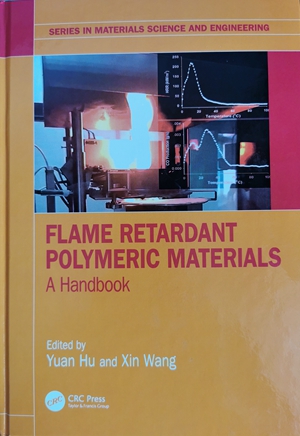
作 者:Yuan Hu,Xin Wang
出 版 社:CRC Press, Taylor & Francis Group
出版时间:2020
ISBN: 9781138295797
Preface
Nowadays the utilization of polymeric materials brings considerable conveniences to our daily life. However, most of polymeric materials possess a fatal drawback, high flammability. There are a large number of property loss and casualties in polymer-related fire accidents every year on this planet. Therefore, more and more countries have set up laws and regulations to ensure that flame retardant treatment is compulsory for polymeric materials used in many fields such as buildings and construction, electrical and electronics, coatings and paints, wire and cables, etc. According to a report from US-based consultancy Grand View Research (Flame Retardant Market Analysis by Product, by Application, by End-Use and Segment Forecasts, 2014–2025), global consumption of flame retardants reached a volume of 2.49 million tonnes in 2015 valued at 6.29 billion USD, which is predicted to exceed 4.0 million tonnes by 2025 valued at 11.96 billion USD with a compound annual growth rate of 4.9% from 2016 to 2025. The rapid development in flame retardant polymeric materials creates the need for an up-to-date monograph that introduces the latest advancements and applications in this field.
Over the past few decades, there are a number of classic monographs on flame retardant polymeric materials, including Fire Retardant Materials by Richard Horrocks and Dennis Price (2001), Fire Retardancy of Polymers: New Applications of Mineral Fillers by Michel Le Bras, Charles A. Wilkie and Serge Bourbigot (2005), Flame Retardant Polymer Nanocomposites by Alexander B. Morgan and Charles A. Wilkie (2007), and Fire Retardancy of Polymeric Materials by Charles A. Wilkie and Alexander B. Morgan (2010). These books cover the broader aspects of flame retardants and their underlying scientific principles. However, some new arising flame retardant materials and techniques, such as graphene and derivatives, molybdenum disulfide, and layer-by-layer assembly have been developed. It is thereby imperative to introduce these latest scientific developments and technological advances to readers in this field.
This book focuses on key topics related to flame retardant of polymers, which is divided into four sections: Fundamentals; Material Modification, Assembly, and Design; Flame Retardant Polymer Nanocomposites; and Applications.
The first section consists of three chapters: introduction (Chapter 1), mechanisms and modes of action in flame retardancy of polymers (Chapter 2), and fire testing for the development of flame retardant polymeric materials (Chapter 3).
The second section then turns to areas of active research in terms of developing new methods and materials, including specific flame retardant systems (phosphorus-, silicon-, and boron-based flame retardants) (Chapters 4-6) and layer-by-layer assembly (Chapter 7).
In the third section, the use of several typical nano-fillers including carbon nanotubes and nanofibers (Chapter 8), graphene (Chapter 9), molybdenum disulfide and layered double hydroxides (Chapter 10) and polyhedral oligomeric silsesquioxane (Chapter 11) for reducing fire hazards of polymeric materials are reviewed and discussed.
The last section is designed to exhibit the latest advances in the current applications of flame retardant polymeric materials in the fields of construction insulating materials (Chapter 12), and wire and cable materials (Chapter 13), textiles (Chapter 14) as well as fiber-reinforced composites (Chapter 15).
We hope that this book will be useful for professionals to develop new fire retardant materials. Also, we hope that it will be of value to graduate students who are interested in fundamentals and applications of flame retardant polymeric materials.
We should express great appreciation to all those who helped enable this book possible, especially the chapter authors who have spent their spare time to share their knowledge to the readers. We also would like to thank the reviewers who have taken time out of their busy lives to review each chapter. Finally, we would like to acknowledge those at Taylor & Francis for their professional organizing and editing work.
Yuan Hu
Xin Wang
